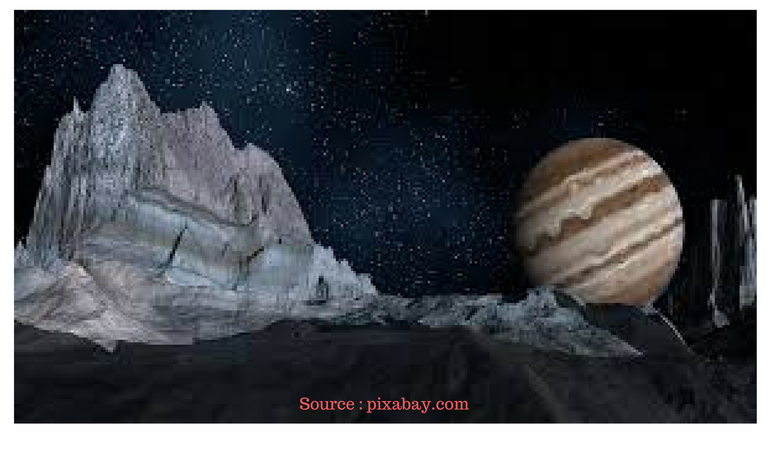But who is really Jupiter? 1st part
This post is an adaptation in english of my post "Mais qui est vraiment Jupiter ?" that I published last month. I would like to share this article with the English-speaking community.

Jupiter is a gaseous giant that reigns over the other planets in our solar system. It is about 1000 times larger than the Earth!
The fifth planet in the solar system, Jupiter has a composition similar to the Sun, but its mass is not large enough to trigger nuclear reactions and form a star.
She moves so far and so fast that she changes everything around her. Without Jupiter, life on Earth might not exist...
It is the largest planet in our solar system, it has a rotation speed (at the equator) of 47,051 km/hour. It revolves around the Sun in 11 years, 10 months and 15 days and on itself in 9h55.
After the Sun, Moon and Venus, Jupiter is the brightest object in the sky.
Its atmosphere is composed of 90% hydrogen and 10% helium, with traces of water, ammonia and methane. It's about -121 degrees on the surface of Jupiter.
A bit of history...
Jupiter is the Roman god of heaven and earth, and the living beings found there. He is also the master of other gods, like Zeus among the Greeks and Shiva among the Hindus. Its attributes are lightning and eagle.
He is part of the triad honored on the Quirinal, then on the Capitol, which included Jupiter, Juno his wife and Minerve his daughter.
Jupiter is the guarantor of treaty fidelity, presiding over international relations through the College of Specialists.
It was in 1610 that Galileo discovered the four satellites of Jupiter: Europa, Ganymede, Callisto and Io. They are now called the Galilean moons.
In Roman mythology, Jupiter draped himself in a cloud to make bad blows!
Jupiter has not only acted on the past of our solar system, but also on its present and future...
Description!
It is situated between the four land-based planets (Mercury, Venus, Earth and Mars which have an active hydrosphere) and the three icy gas giants located after it (Saturn, Uranus and Pluto).
There is on its surface a storm as big as four times the Earth that has raged for hundreds of years!
She has dozens of moons, a huge magnetic field: everything is excessive at home and she does nothing on a small scale...
For cosmologist Lawrence M. Krauss:"If we looked at the solar system from afar, we would see the Sun, Jupiter and small pebbles".
This giant contains many clues about the creation of our solar system and its future disappearance.
You don't see its surface but the top of a cloud, and this cloud of gas hides secrets...
Michelle Thaller (Astronomer) explains that:"One of the greatest mysteries of Jupiter is what is in its center, its core and we don't know it yet".
As it is a gaseous giant, the more one descends into its atmosphere, the denser it is and the higher the pressure!
.png)
After flying over Jupiter for years, on 07 December 1995, the Galileo probe dropped a titanium probe into Jupiter's atmosphere. It penetrated the clouds at over 170,000 km/h.
Michio Kaku (theoretical physicist) tells us that:"If Jupiter looks calm from afar, approaching us we realize that there are very strong winds, storms and pressures capable of crushing any instrument".
Sensors of the probe indicated that the atmosphere has 90% hydrogen and that the temperature can rise to more than 150 degrees Celsius and that the winds are blowing at 640 km/h! After having covered 152 kilometers for 58 minutes in the Jovian atmosphere, the Galileo probe disintegrated leaving us with no answer...
Jupiter's heart
According to numerical simulations by geophysicists, the giant planet will contain a rocky core with a much thicker layer of ice than previously thought. This idea is consistent with the data provided by the Galileo probe.
At the National Ignition Facility (NIF) in San Francisco, researchers are able to recreate the conditions on Jupiter. They take hydrogen and freeze it to increase its density, and use the world's most powerful laser to bombard hydrogen. At this extreme pressure, equivalent to 100 million atmospheres, the chemistry is entirely different: instead of distorting the chemical bonds, the atom is modified. Matter does not behave
as on Earth! The atoms decompose and hydrogen passes from the gaseous state to the liquid state.
It looks like a metallic liquid found in the depths of Jupiter. Its center could look like a giant ball of mercury that can rise to 6000 degrees on its periphery!
But the inside remains a mystery... rock? Ice cream? Probably a solid core...
A documentary MMXIV DISCOVERY COMMUNICATIONS, LLC
https://www.futura-sciences.com/sciences/definitions/univers-jupiter-3714/ https://mythologica.fr/rome/jupiter.htm https://www.newscientist.com/article/dn21317-jupiters-heart-is-dissolving/ https://www.futura-sciences.com/sciences/actualites/astronomie-coeur-jupiter-rocheux-glace-17504/
See you soon for the 2nd part of this article on planet Jupiter...
Join the #steemSTEM channel, a community project to promote science, engineering, mathematics and technology on Steemit.